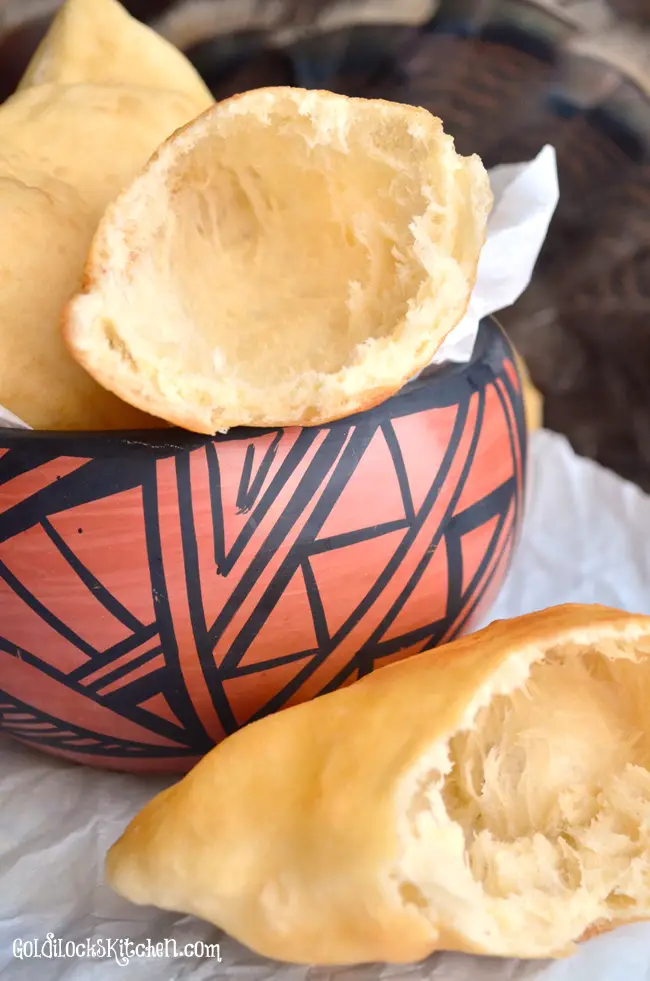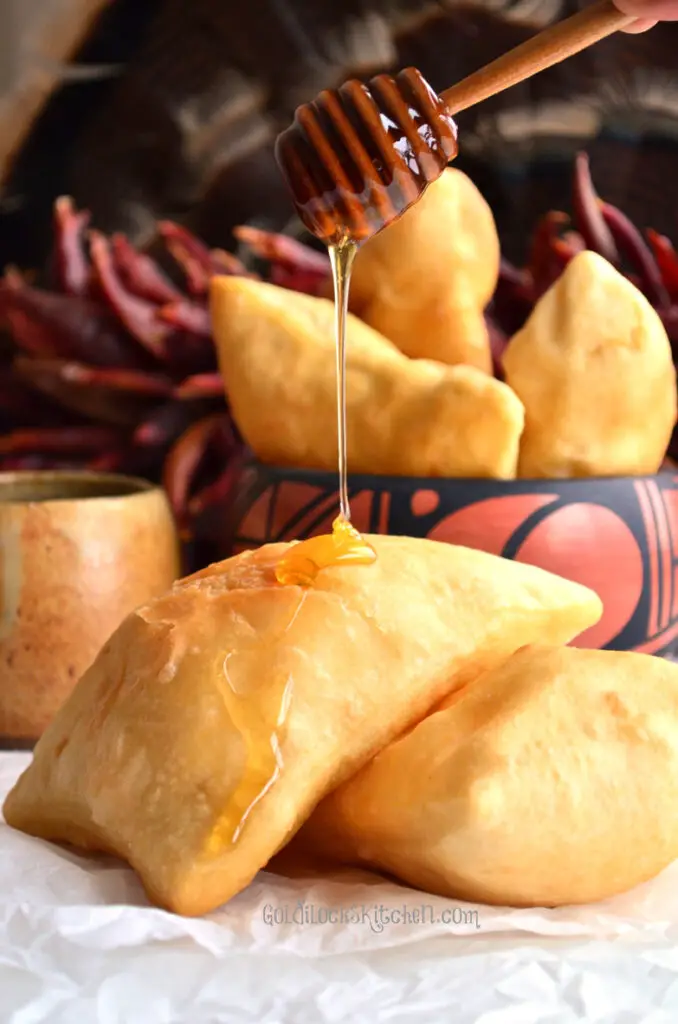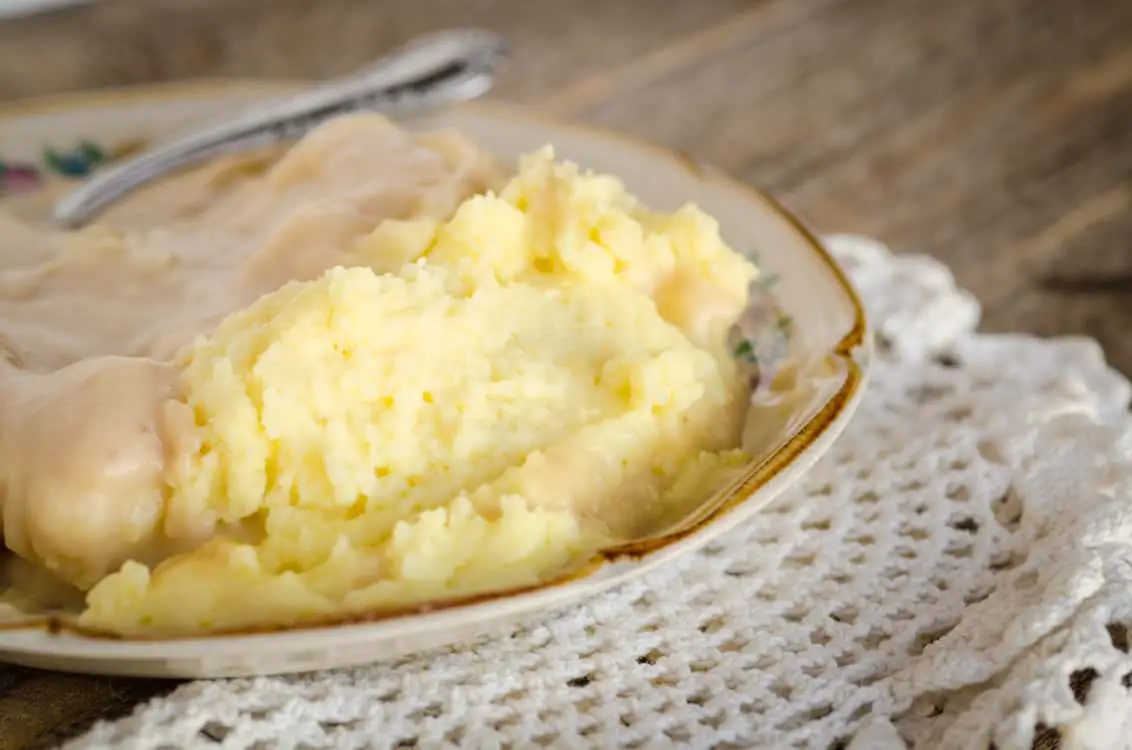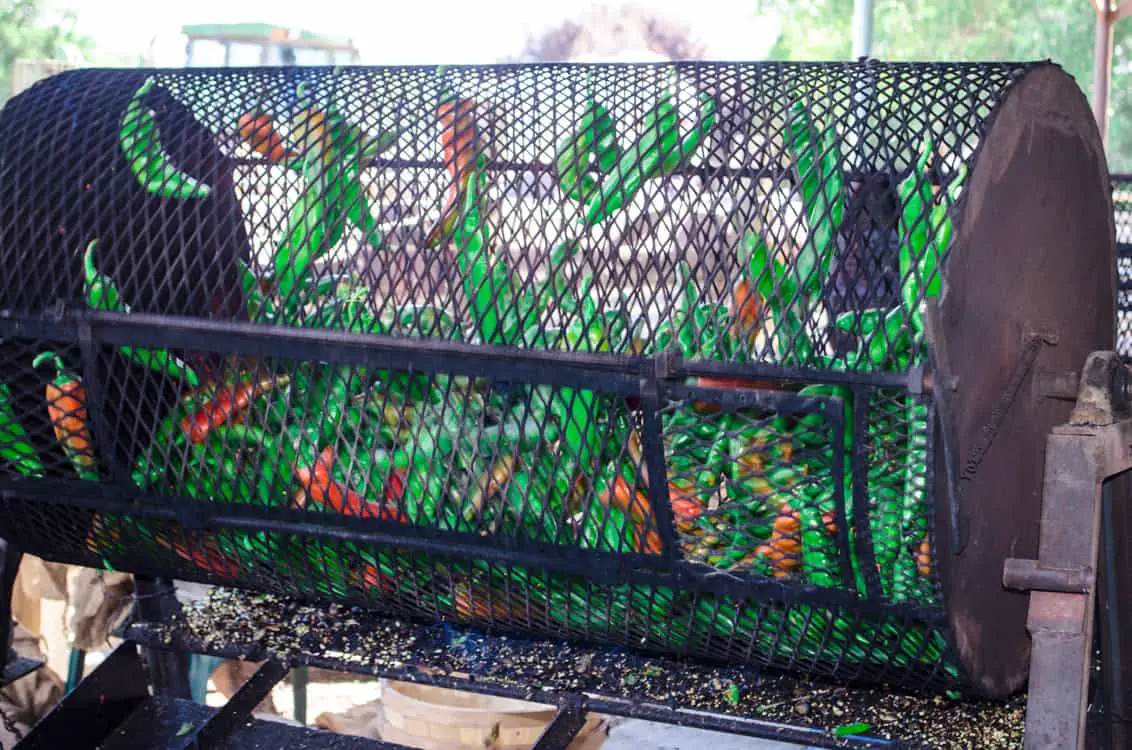Authentic New Mexican Sopapilla Recipe
Delight Everyone at the Table when you Include a Basket of Authentic New Mexican Sopapillas
What is a sopapilla?
Sopapillas are NOT scones. Any New Mexican will quickly correct you if you call them that. We try not to be offended because we know most folks outside of our state don’t know what they are. Now you know what they aren’t, so let me tell you what they are.
Authentic New Mexican Sopapillas are ‘little pillows’ of fried dough. They are made with white flour, warm water, baking powder, salt, sugar, and vegetable oil. What makes a sopapilla puff? The inflation comes when some of the water in the dough is converted to steam which puffs the dough from the inside out. I love watching them cook!
Many people who have grown up in NM believe that sopapillas are a local creation. The answer is, yes and no. Our Nuevo Mexico version has been influenced by all the native fry bread that is eaten in the region. But a lot of countries south of the border also have sopapillas- each reflecting their country of origin.
Where did Sopapillas Originate?
The sopapillas we enjoy today originated with Spanish influence, which permeated throughout South America and of course, into North America as well several hundred years ago. People in Peru, Argentina, Chile, and even Uruguay each have their own form of sopapillas.
The Spanish may not have invented it either, because the name sopapilla or sopaipilla, or sopaipa, originates from the word Xopaipa, an Arabic word for bread soaked in liquid! Remember in history class when you learned that the Arab world controlled Spain for a while? Yeah, me neither. But it did and left us all to enjoy sopapillas today (and you have something interesting to think about next time you bite into one).

Anyway, back to food talk 😋
You talk about being full of hot air, the pocket inside is the perfect cavity for filling with all sorts of delicious things like honey, frijoles con carne (refried beans and meat), or even ice cream. Sopapillas can be eaten as an appetizer, main course, or dessert!
Are Beignets and Sopapillas the same thing?
Beignets (pronounced: Ben-yay’s) and Sopapillas ARE NOT the same thing. Beignets are a deep fried dough consisting of yeast, sugar, flour, eggs, milk, and butter. They do not puff up hollow when fried. New Mexican Sopapillas puff up hollow like a balloon when fried and have a much simpler dough consisting of just flour, baking soda, salt, vegetable oil and a touch of sugar. Beignets are served with a generous dusting of powdered sugar, New Mexican Sopapillas are served just with honey, or are stuffed with beans or meat as an entrée.
Next to Hatch Green Chile, the Sopapilla is the iconic symbol of New Mexican food and can be found in just about every regional fare restaurant!
What is the difference between Fry bread and Sopapillas?
In the state of New Mexico, Sopapillas and fry bread have two main differences: Sopapilla dough is rolled out thick and cut into pieces about the size of your hand. The thickness of the dough allows steam to fill the inside puffing the dough up like a balloon when placed into the hot oil. Native or Indian Fry bread is larger in size, about the shape and size of a personal pizza, shaped only by hand (never rolled out with a rolling pin), and does not completely puff up when placed in hot oil. Rather, it has sporadic puffy spots throughout.
One of the amazing things I love about the Southwest is the rich history and culture of the area. The integration of Hispanic and Native American traditions permeates everything from architecture to food. Take a drive by one of the Pueblos on a summer weekend and you’ll probably be able to buy fresh fry bread roadside. Make sure you stop and try some; I love it!
Can Sopapilla dough be made ahead?
According to my experiments, the answer is yes, although there are limitations. Sopapilla dough can be refrigerated overnight, but that’s as long as I’d let it stay there. After the dough is made it will slowly oxidize, turning a not-so-appealing color of grey. After you get it out of the fridge, it will be VERY sticky, so kneading in more flour will be necessary, then follow that step with another 20-minute rest to allow the gluten in the dough to relax so it can be rolled out into the proper thickness. You may also notice that not as many sopapillas will puff up properly; approximately 25% of my dough didn’t puff up properly. But it will still taste good!
I had little success freezing sopapilla dough. By the time it had thawed out on my counter it was like trying to work with taffy it was soooo sticky. And it fried up weird also. I would not recommend freezing sopapilla dough.
How do you eat Sopapillas?
There are two ways New Mexicans eat sopapillas; the first bite of a fresh warm sopapilla is always the corner- then we drizzle honey inside, via the hole created by the missing corner. The other way to eat them is to stuff them with refried beans, taco meat, or shredded meat (like chicken or pork), then smother them in red or green chile sauce, as is the traditional New Mexican way. Oh the joys of sopapilla eating, how I love thee…… 😁😁😁😁
I have never been served sopapillas at any restaurant in The Land of Enchantment (NM) that were sprinkled with powdered sugar. I think sometimes out of state chefs still treat them like beignets, even though they are quite clearly, not beignets.
Why do Sopapillas puff up?
When that moist dough hits hot cooking oil, two things happen: steam fills the inside of the sopapilla like party balloons for your birthday AND the baking powder in the dough begins to produce carbon dioxide. It’s a mixture of these two factors that puffs up this crazy dough into all kinds of fun shapes!
There is no secret ingredient sauce or technique for making sopapillas, they are actually quite simple. The most important thing to remember is to keep the dough moist. If it dries out, it will lose its elasticity and fry up as a really big tortilla chip. If the dough is over-kneaded, too much gluten will form and you won’t be able to roll the dough out to the proper thickness either. If you follow my instructions they should turn out just right every time! And thank you so much to my friend Genevieve who taught me this recipe so long ago. :0)
Print
Authentic New Mexican Sopapillas
- Total Time: 30 minutes
- Yield: 12 sopapillas 1x
Description
Puffy, golden and hollow, Sopapillas are the hallmark of New Mexican food. Their crispy yet soft texture is delicious and is simply amazing when drizzled with honey, or stuffed with a delicious hearty filling.
Ingredients
- 4 cups flour, sifted
- 1 tablespoon baking powder
- 1 teaspoon salt
- 1 tablespoon sugar
- 2 tablespoons vegetable oil + 2 2/1 cups for frying (shortening or lard can be used instead of vegetable oil)
- 1 1/3 cups warm water
Instructions
- In a large mixing bowl whisk the flour, baking powder, salt, and sugar together. Create a small depression in the center and pour in 2 tablespoons of vegetable oil. Whisk the oil around in the dry ingredients until little clumps form.
- Gently pour warm water into the bowl and stir with a wooden spoon just until the dough just comes together. Dump the dough out onto a clean work surface and continue to knead the dough by hand until it becomes smooth. Divide the dough in half, and seal each half in a zipper-lock bag while you proceed with step 3.
- Heat frying oil in a stove-top dutch oven or a heavy-duty frying pan to around 350 to 375 degrees. The oil should be at least 2 inches deep. When the oil comes to temperature remove a bag from one portion of dough and roll the dough to a thickness of 1/8 inch. Using a pizza cutter, cut the dough into squares approximately 4 X 4 for a nice restaurant look. (You can also fry up the extra triangles that are left if you like.)
- Place a sheet of plastic wrap over the rolled and cut dough; it’s very important the dough stay moist and not dry out while you fry each piece, or it won’t puff. Gently lift up one square of dough and slide it into the hot oil. It should begin to puff up within about 5-10 seconds. Use a large spoon or tongs to carefully splash oil over the top until the underside is golden brown, about 30 – 60 seconds.
- Flip and fry the other side until both sides are light golden brown. Remove from oil and place in a large bowl lined with paper towels. Repeat with the remaining dough. Serve immediately with honey or stuffing and chile sauce.
- Prep Time: 10 minutes
- Cook Time: 20 minutes
- Category: Side
- Cuisine: New Mexican










These look like the real deal…thanks for sharing the recipe.
Good recipe
Will these keep well overnight?
This comment has been removed by the author.
Sopapillas are best served immediately after frying, they get kind of chewy/tough after a while. I've eaten them the next day but I wouldn't serve them to guests if you're planning on entertaining. Hope that helps :0)
stuff them with pinto beans YUM
Can't wait to try these. They look fabulous. Missing New Mexican food so this will be great! Thank you for sharing the recipe.
Thank you so much for sharing this recipe.
Thank's for tips. Amazing review of this Sopa-pee-ya. Would love to try this and same time. I'm really impressed to see this nice food. happycookerz
Clear, informative, simple. Love your post!
Thanks so much Angel!
That looks delicious!
I will try your tips the next time. Thank you for sharing this!
Thank you for sharing!
You’re very welcome Sarah, hope you enjoy them as much as I do!
This look so delicious. Will be making this a recipe for my family.
Thanks Cynthia!
My family is from New Mexico and I have tried and tried to make sopapillas in the past to no avail. These came out puffy and wonderful, I really impressed my family, now they want the all the time!. Thank you so much for this keeper.
Hi Josie, I’m so glad you and your family loved the Sopapillas! Keep an eye out for my new book: “New Mexican Food Made Easy”. There will be even more great sopapilla recipes, tips and hacks to share the foods we love so much with friends and family everywhere! I’m aiming to have it done by the beginning of November and it will be available on amazon.com. Thanks for sharing your wonderful experience!
This reminds me of my years of going to school in Santa Fe, and visiting friends at the Pueblos. Also of walking across Cerrillos Road ro the little Mom & Pop restaurant to get coffee and sopapillas.
Isn’t it wonderful how just a simple piece of fried dough can bring back such wonderful nostalgia? Food is so much more than just fulfilling a need, it brings friends and family together and is the medium for creating lasting memories. Thanks for sharing Dolores!
How many does this recipe generally make?
Hi Emily!
This recipe will make somewhere in the range of 10-14. IT largely depends on how large you cut them. Hope that’s helpful:0)
I have a deep fat fryer, would it work to cook these?
Hi Kathy,
Yes definitely! Especially if you can set the fryer to the temp specified in the recipe. Go for it and let me know how they turn out! Thanks for the question :0)
Can the dough be frozen or refrigerated for later use?
That is a very important question worth some research- I refrigerated some dough a long time ago and I seem to remember that it turned a not-so-yummy-looking gray color… but I don’t remember exactly how long it was in the fridge. I have never tried freezing it. I will make some dough TODAY and place some in the fridge and the rest in the freezer. Tomorrow I will try to fry some up and get you a definitive answer on December 2nd. So stay tuned! :0)